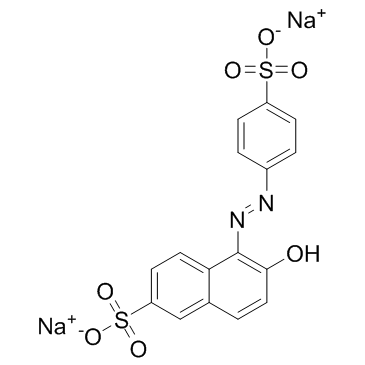Sunset yellow

Sunset yellow structure
|
Common Name | Sunset yellow | ||
|---|---|---|---|---|
| CAS Number | 2783-94-0 | Molecular Weight | 452.369 | |
| Density | N/A | Boiling Point | N/A | |
| Molecular Formula | C16H10N2Na2O7S2 | Melting Point | 390°C (dec.) | |
| MSDS | Chinese USA | Flash Point | N/A | |
| Symbol |

GHS07 |
Signal Word | Warning | |
|
Kinetics of adsorption of sulphonated azo dyes on strong basic anion exchangers.
Environ. Technol. 30(10) , 1059-71, (2009) The macroporous polystyrene anion exchangers Amberlite IRA-900 and Amberlite IRA-910 were used in order to remove sulphonated azo dyes (Allura Red and Sunset Yellow) from aqueous solutions of 100-500 mg/L concentrations. The experimental data obtained at 100,... |
|
|
Pattern of intake of food additives associated with hyperactivity in Irish children and teenagers.
Food Addit. Contam. Part A. Chem. Anal. Control. Expo. Risk Assess. 27(4) , 447-56, (2010) A double-blind randomized intervention study has previously shown that a significant relationship exists between the consumption of various mixes of seven target additives by children and the onset of hyperactive behaviour. The present study set out to ascert... |
|
|
Toxicity of xanthene food dyes by inhibition of human drug-metabolizing enzymes in a noncompetitive manner.
J. Environ. Public Health 2009 , 953952, (2009) The synthetic food dyes studied were rose bengal (RB), phroxine (PL), amaranth, erythrosine B (ET), allura red, new coccine, acid red (AR), tartrazine, sunset yellow FCF, brilliant blue FCF, and indigo carmine. First, data confirmed that these dyes were not s... |
|
|
Simultaneous kinetic spectrophotometric analysis of five synthetic food colorants with the aid of chemometrics.
Talanta 78(2) , 432-41, (2009) This paper describes a simple and sensitive kinetic spectrophotometric method for the simultaneous determination of Amaranth, Ponceau 4R, Sunset Yellow, Tartrazine and Brilliant Blue in mixtures with the aid of chemometrics. The method involved two coupled re... |
|
|
Fast chromatographic method for the determination of dyes in beverages by using high performance liquid chromatography—Diode array detection data and second order algorithms
J. Chromatogr. A. 1216(42) , 7063-70, (2009) A fast chromatographic methodology is presented for the analysis of three synthetic dyes in non-alcoholic beverages: amaranth (E123), sunset yellow FCF (E110) and tartrazine (E102). Seven soft drinks (purchased from a local supermarket) were homogenized, filt... |
|
|
Immunological studies on Amaranth, Sunset Yellow and Curcumin as food colouring agents in albino rats
Food Chem. Toxicol. 48(6) , 1581-6, (2010) The use of food dyes is at least controversial because they are only of essential role. Moreover many of them have been related to health problems mainly in children that are considered a very vulnerable group. This study was carried out to investigate the ef... |
|
|
Development of a polyclonal antibody-based enzyme-linked immunosorbent assay (ELISA) for detection of Sunset Yellow FCF in food samples.
Talanta 99 , 125-31, (2012) Sunset Yellow FCF is widely used as food additives to make foods more attractive. Due to its abuse and potential risk to human health, Sunset Yellow FCF is precisely limited to use in food. To monitor the illegal use of Sunset Yellow FCF, a polyclonal antibod... |
|
|
On the inversion of diffusion NMR data: Tikhonov regularization and optimal choice of the regularization parameter.
J. Magn. Reson. 211(2) , 178-85, (2011) The analysis of diffusion NMR data in terms of distributions of diffusion coefficients is hampered by the ill-posed nature of the required inverse Laplace transformation. Naïve approaches such as multiexponential fitting or standard least-squares algorithms a... |
|
|
NMR characterization of the aggregation state of the azo dye sunset yellow in the isotropic phase.
J. Phys. Chem. B 114(31) , 10032-8, (2010) The azo dye sunset yellow is known to form lyotropic liquid crystals as a function of both temperature and sample composition. Numerous studies have been performed to investigate the aggregation processes in these liquid crystals; however, less attention has ... |
|
|
Effects of different food colorants and polishing techniques on color stability of provisional prosthetic materials.
Dent. Mater. J. 29(2) , 167-76, (2010) The main objective was to investigate the effects of different polishing techniques on the color stability of provisional prosthetic materials upon exposure to different staining agents by mimicking the oral environment in vitro. Fifty-six cylindrical specime... |